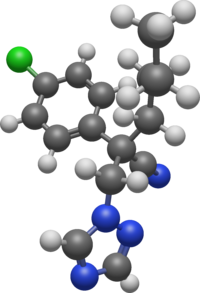Chemistry:Myclobutanil

| |

| |
| Names | |
|---|---|
| IUPAC name
2-(4-Chlorophenyl)-2-(1,2,4-triazol-1-ylmethyl)hexanenitrile
| |
| Identifiers | |
3D model (JSmol)
|
|
| 7138849 | |
| ChEBI | |
| ChemSpider | |
| EC Number |
|
| KEGG | |
| MeSH | Systhane |
PubChem CID
|
|
| RTECS number |
|
| UNII | |
| UN number | 3077 |
| |
| |
| Properties | |
| C15H17ClN4 | |
| Molar mass | 288.78 g·mol−1 |
| Appearance | Pale, yellow, translucent crystals |
| Melting point | 63 to 68 °C (145 to 154 °F; 336 to 341 K) |
| Boiling point | 202 to 208 °C (396 to 406 °F; 475 to 481 K) at 130 Pa |
| 142 mg⋅dm−3 | |
| Hazards | |
| GHS pictograms |   
|
| GHS Signal word | Warning |
| H302, H319, H361, H411 | |
| P273, P281, P305+351+338 | |
| NFPA 704 (fire diamond) | |
| Flash point | > 100 °C (212 °F; 373 K) |
Except where otherwise noted, data are given for materials in their standard state (at 25 °C [77 °F], 100 kPa). | |
| Infobox references | |
Myclobutanil is a triazole chemical used as a fungicide. It is a steroid demethylation inhibitor, specifically inhibiting ergosterol biosynthesis.[1] Ergosterol is a critical component of fungal cell membranes.
Stereoisomerism
| Myclobutanil (2 stereoisomers) | |
|---|---|
 (S)-configuration |
 (R)-configuration |
Safety
The Safety Data Sheet indicates the following hazards:
- Suspected of damaging fertility or the unborn child.
- Toxic to aquatic life with long lasting effects.[2]
The first hazard has caused this chemical to be placed on the 1986 California Proposition 65 toxics list.
When heated, myclobutanil decomposes to produce corrosive and/or toxic fumes, including carbon monoxide, carbon dioxide, hydrogen chloride, hydrogen cyanide, and nitrogen oxides.[3][4]
Banned for cannabis cultivation
Myclobutanil is banned in Canada , Colorado, Washington (state) , Oregon, and Oklahoma for the production of medical and recreational cannabis. In 2014, a Canadian news investigation by The Globe and Mail reported the discovery of myclobutanil in medical cannabis produced by at least one government licensed grower.[5] In September 2019, NBC News commissioned CannaSafe to test THC cartridges for heavy metals, pesticides, and residual solvents like Vitamin E; pesticides, including myclobutanil, was found in products from unlicensed dealers.[6] In Michigan, the current state action limit for myclobutanil is 200 ppb in cannabis products.[7]
References
- ↑ "Myclobutanil Product Sheet". Kingtai Chemicals Co.. http://www.kingtaichem.com/pro_f_MYCLOBUTANIL.htm.
- ↑ "SAFETY DATA SHEET Myclobutanil". Cayman Chemical Company. https://www.caymanchem.com/msdss/24100m.pdf.
- ↑ GOV, NOAA Office of Response and Restoration, US. "MYCLOBUTANIL - CAMEO Chemicals - NOAA". https://cameochemicals.noaa.gov/chemical/30020.
- ↑ "Product Safety Assessment: Myclobutanil". http://www.dow.com/webapps/include/GetDoc.aspx?filepath=productsafety/pdfs/noreg/233-01023.pdf&pdf=true.
- ↑ "Canadians not told about banned pesticide found in medical pot supply". https://www.theglobeandmail.com/news/national/canadians-not-told-about-banned-pesticide-found-in-medical-marijuana-supply/article33443887/.
- ↑ "Tests show bootleg marijuana vapes tainted with hydrogen cyanide". https://www.nbcnews.com/health/vaping/tests-show-bootleg-marijuana-vapes-tainted-hydrogen-cyanide-n1059356.
- ↑ "Technical Bulletin". https://www.michigan.gov/documents/lara/Department_Banned_Pesticide_Active_Ingredient_List_620039_7.pdf&pdf=true.
External links
- Myclobutanil in the Pesticide Properties DataBase (PPDB)
- International Programme on Chemical Safety
 |


